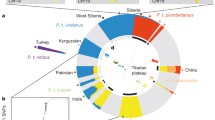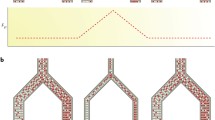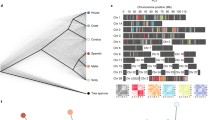Abstract
The interplay between hybridization and recombination can have a dramatic effect on the likelihood of speciation or persistence of incompletely isolated species. Many models have suggested recombination can oppose speciation, and several recent empirical investigations suggest that reductions in recombination between various components of reproductive isolation and/or adaptation can allow species to persist in the presence of gene flow. In this article, we discuss these ideas in relation to speciation models, phylogenetic analyses, and species concepts. In particular, we revisit genetic architectures and population mechanisms that create genetic correlations and facilitate divergence in the face of gene flow. Linkage among genes contributing to adaptation or reproductive isolation due to chromosomal rearrangements as well as pleiotropy or proximity of loci can greatly increase the odds of species divergence or persistence. Finally, we recommend recombination to be a focus of inquiry when studying the origins of biological diversity.
Similar content being viewed by others
References
Anderson, W.W., T. Dobzhansky, O. Pavlovsky, J.R. Powell & D. Yardley, 1975. Three decades of genetic change in Drosophila pseudoobscura. Evolution 29: 24–36.
Anderson, W.W., J. Arnold, D.G. Baldwin, A.T. Beckenbach, C.J. Brown, S.H. Bryant, J.A. Coyne, L.G. Harshman, W.B. Heed, D.E. Jeffery, L.B. Klaczko, B.C. Moore, J.M. Porter, J.R. Powell, T. Prout, S.W. Schaeffer, J.C. Stephens, C.E. Taylor, M.E. Turner, G.O. Williams & J.A. Moore, 1991. Four decades of inversion polymorphism in Drosophila pseudoobscura. P. Natl. Acad. Sci. USA 88: 10367–10371.
Aquadro, C.F., A.L. Weaver, S.W. Schaeffer & W.W. Anderson, 1991. Molecular evolution of inversions in Drosophila pseudoobscura: the amylase gene region. P. Natl. Acad. Sci. USA 88: 305–309.
Ballard, J.W., 2000. When one is not enough: introgression of mitochondrial DNA in Drosophila. Mol. Biol. Evol. 17: 1126–1130.
Barton, N.H. & B.O. Bengtsson, 1986. The barrier to genetic exchange between hybridizing population. Heredity 56: 357–376.
Barton, N.H.& G.M. Hewitt, 1985. Analysis of hybrid zones. Annu. Rev. Ecol. Syst. 16: 113–148.
Barton, N.H. & M. Turelli, 1991. Natural and sexual selection on many loci. Genetics 127: 229–255.
Berlocher, S.H. & J.L. Feder, 2002. Sympatric speciation in phytophagous insects: moving beyond the controversy? Annu. Rev. Entomol. 47: 773–815.
Brooks, R., 2000. Negative genetic correlation between male sexual attractiveness and survival. Nature 406: 67–70.
Carpenter, A.T.C., 1979. Synaptonemal complex and recombination nodules in wild-type Drosophila melanogaster females. Genetics 92: 511–541.
Carson, H.L., 1975. The genetics of speciation at the diploid level. Am. Nat., 109: 83–92.
Diehl, S.R. & G.L. Bush, 1989. The Role of Habitat Preference in Adaptation and Speciation. Sinauer Press, Sunderland, Massachusetts.
Dobzhansky, T., 1951. Genetics and the Origin of Species. Columbia University Press, New York.
Dobzhansky, T., 1973. Is there gene exchange between Drosophila pseudoobscura and Drosophila persimilis in their natural habitats? Am. Nat., 107: 312–314.
Felsenstein, J., 1981. Skepticism towards Santa Rosalia, or why are there so few kinds of animals? Evolution 35: 124–138.
Hamilton, W.D. & M. Zuk, 1982. Heritable true fitness and bright birds: a role for parasites. Science 218: 384–387.
Harrison, R.G., 1993. Hybrid Zones and the Evolutionary Process. Oxford University Press, New York.
Hawthorne, D.J. & S. Via, 2001. Genetic linkage of ecological specialization and reproductive isolation in pea aphids. Nature 412: 904–907.
Higa, I. & Y. Fuyama, 1993. Genetics of food preference in Drosophila sechellia. I. Responses to food attractants. Genetica 88: 129–136.
Hostert, E.E., 1997. Reinforcement: a new perspective on an old controversy. Evolution 51: 697–702.
Hutter, C.M. & D.M. Rand, 1995. Competition between mitochondrial haplotypes in distinct nuclear genetic environments: Drosophila pseudoobscura v.s. D. persimilis. Genetics 140: 537–548.
Johnson, N.A., 2000. Gene interactions and the origin of species, pp. 197–212 in Epistasis and the Evolutionary Process, edited by I.B. Wolf, E.D. Brodie & M. Wade. Oxford University Press, New York.
Jones, C., 1998. The genetic basis of Drosophila sechellia's resistance to a host plant toxin. Genetics 149: 1899–1908.
Kirkpatrick, M., 1982. Sexual selection and the evolution of female choice. Evolution 36: 1–12.
Kirkpatrick, M. & N.H. Barton, 1997. The strength of indirect selection on female mating preferences. P. Natl. Acad. Sci. USA 94: 1282–1286.
Kirkpatrick, M. & V. Ravigné, 2002. Speciation by natural and sexual selection. Am. Nat. 159: 522–535.
Kliman, R.M., P. Andolfatto, J.A. Coyne, F. Depaulis, M. Kreitman, A.J. Berry, J. McCarter, J. Wakeley & J. Hey, 2000. The population genetics of the origin and divergence of the Drosophila simulans complex species. Genetics 156: 1913–1931.
Kotiaho, J.S., L.W. Simmons & J.L. Tomkins, 2001. Towards a resolution of the lek paradox. Nature 410: 684–686.
Lande, R., 1981. Models of speciation by sexual selection on polygenic traits. P. Natl. Acad. Sci. USA 78: 3721–3725.
Li, W.H. & M. Nei, 1974. Stable linkage disequilibrium without epistasis in subdivided populations. Theor. Popul. Biol. 6: 173–183.
Li, Z., S.R.M. Pinson, A.H. Paterson, W.D. Park & J.W. Stansel, 1997. Genetics of hybrid sterility and hybrid breakdown in an intersubspecific rice (Oryza sativa L.) population. Genetics 145: 1139–1148.
Lindsley, D.L. & L. Sandler, 1977. The genetic analysis of meiosis in female Drosophila melanogaster. Philos. T. Roy. Soc. B 277: 295–312.
Liou, L.W. & T.D. Price, 1994. Speciation by reinforcement of premating isolation. Evolution 48: 1451–1459.
Machado, C.A., R.M. Kliman, J.A. Markert & J. Hey, 2002. Inferring the history of speciation from multilocus sequence data: the case of Drosophila pseudoobscura and its close relatives. Mol. Biol. Evol. 19: 472–488.
Mallet, J., 1995. A species definition for the modern synthesis. Trends Ecol. Evol. 10: 294–299.
Mayr, E., 1963. Animal Species and Evolution. Belknap Press, Cambridge, MA.
Nachman, M.W. & G.A. Churchill, 1996. Heterogeneity in rates of recombination across the mouse genome. Genetics 142: 537–548.
Nitao, J.K., M.P. Ayres, R.C. Laderhouse & J.M. Scriber, 1991. Larval adaptation to lauraceosus hosts: geographic divergence in the spicebush swallowtail butterfly. Ecology 72: 1428–1435.
Noor, M.A.F., 1997. Genetics of sexual isolation and courtship dysfunction in male hybrids of Drosophila pseudoobscura and D. persimilis. Evolution 51: 809–815.
Noor, M.A.F., A.L. Cunningham & J.C. Larkin, 2001a. Consequences of recombination rate variation on quantitative trait locus mapping studies: simulations based on the Drosophila melanogaster genome. Genetics 159: 581–588.
Noor, M.A.F., K.L. Grams, L.A. Bertucci, Y. Almendarez, J. Reiland & K.R. Smith, 2001b. The genetics of reproductive isolation and the potential for gene exchange between Drosophila pseudoobscura and D. persimilis via backcross hybrid males. Evolution 55: 512–521.
Noor, M.A.F., K.L. Grams, L.A. Bertucci & J. Reiland, 2001c. Chromosomal inversions and the reproductive isolation of species. P. Natl. Acad. Sci. USA 98: 12084–12088.
Otto, S.P., 1991. On evolution under sexual and viability selection: a two-locus diploid model. Evolution 45: 1443–1457.
Palopoli, M.F. & C.-I. Wu, 1994. Genetics of hybrid male sterility between Drosophila sibling species: a complex web of epistasis is revealed in interspecific studies. Genetics 138: 329–341.
Palopoli, M.F., A.W. Davis & C.-I. Wu, 1996. Discord between the phylogenies inferred from molecular versus functional data: uneven rates of functional evolution or low levels of gene flow? Genetics 144: 1321–1328.
Payseur, B.A. & M.W. Nachman, 2000. Microsatellite variation and recombination rate in the human genome. Genetics 156: 1285–1298.
Perez, D.E., C.-I. Wu, N.A. Johnson & M.-L. Wu, 1993. Genetics of reproductive isolation in the Drosophila simulans clade: DNA marker-assisted mapping and characterization of a hybrid-male sterility gene, Odysseus (Ods). Genetics 134: 261–275.
Powell, J.R., 1983. Interspecific cytoplasmic gene flow in the absence of nuclear gene flow: evidence from Drosophila. P. Natl. Acad. Sci. USA 80: 492–495.
Pritchard, J.K. & M. Przeworski, 2001. Linkage disequilibrium in humans: models and data. Am. J. Hum Genet. 69: 1–14.
Rice, W.R. & E.E. Hostert, 1993. Laboratory experiments on speciation: what have we learned in forty years? Evolution 47: 1637–1653.
Rieseberg, L.H., 2001. Chromosomal rearrangements and speciation. Trends Ecol. Evol. 16: 351–358.
Rieseberg, L.H., J. Whitton & K. Gardner, 1999. Hybrid zones and the genetic architecture of a barrier to gene flow between two sunflower species. Genetics 152: 713–727.
Roulin, A., T.W. Jungi, H. Pfister & E. Dijkstra, 2000. Female barn owls (Tyto alba) advertise good genes. P. Roy. Soc. Lond. B 267: 937–941.
Sanderson, N., 1989. Can gene flow prevent reinforcement? Evolution 43: 1223–1235.
Schaeffer, S.W. & E.L. Miller, 1991. Nucleotide sequence analysis of Adh genes estimates the time of geographic isolation of the Bogota population of Drosophila pseudoobscura. P. Natl. Acad. Sci. USA 88: 6097–6101.
Scriber, J.M., 1986. Allelochemicals and alimentary ecology: heterosis in a hybrid zone? in Molecular Aspects of Insect-Plant Associations, edited by L.B. Brattsten & S. Admad. Plenum, New York.
Scriber, J.M., B.L. Giebink & D. Snider, 1991. Reciprocal latitudinal clines in ovisposition behavior of Papilo glaucus and P. canadensis across the Great Lakes hybrid zone: possible sex-linkage of oviposition preferences. Oecologia 81: 360–368.
Servedio, M.R., 2000. Reinforcement and the genetics of nonrandom mating. Evolution 54: 21–29.
Sezer, M. & R.K. Butlin, 1998. The genetic basis of oviposition preference differences between sympatric host races of the brown planthopper (Nilaparvata lugens). P. Roy. Soc. Lond. B 265: 2399–2405.
Shaw, D.D., P. Wilkinson & C. Moran, 1983. A comparison of chromosomal and allozymal variation across a narrow hybrid zone in the grasshopper Caledia captiva. Chromosoma 75: 333–351.
Singer, M.C., D. Ng & C.D. Thomas, 1988. Heritability of oviposition preference and its relationship to offspring performance within a single insect population. Evolution 42: 977–985.
Takimoto, G., M. Higashi & N. Yamamura, 2000. A deterministic genetic model for sympatric speciation by sexual selection. Evolution 54: 1870–1881.
Taylor, C.E. & J.R. Powell, 1978. Habitat choice in natural populations of Drosophila. Oecologia 37: 69–75.
Thompson, J.N., ed, 1994. The Coevolutionary Process. The University of Chicago Press, Chicago.
Thompson, J.N., W. Wehling & R. Podolsky, 1990. Evolutionary genetics of host use in swallowtail butterflies. Nature 148–150.
Ting, C.-T., S.-C. Tsaur & C.-I. Wu, 2000. The phylogeny of closely related species as revealed by the genealogy of a speciation gene, Odysseus. P. Natl. Acad. Sci. USA 97: 5313–5316.
Trickett, A.J. & R.K. Butlin, 1994. Recombination suppressors and the evolution of new species. Heredity 73: 339–345.
Turner, J.R.G., 1967. The evolution of supergenes. Am. Nat.: 195–228.
Turner, J.R.G., 1967. Why does the genotype not congeal? Evolution 21: 645–656.
Via, S., 1990. Ecological genetics and host adaptation in herbivorous insects-the experimental-study of evolution in natural and agricultural systems. Annu. Rev. Entomol. 35: 421–446.
Wallace, B.M.N. & J.B. Searle, 1994. Oogenesis in homozygotes and heterozygotes for robertsonian chromosomal rearrangements from natural-populations of the common shrew, Sorex-araneus. J. Reprod. Fertil. 100: 231–237.
Wang, R.L., J. Wakeley & J. Hey, 1997. Gene flow and natural selection in the origin of Drosophila pseudoobscura and close relatives. Genetics 147: 1091–1106.
Welch, A.M., R.D. Semlitsch & H.C. Gerhardt, 1998. Call duration as an indicator of genetic quality in male gray tree frogs. Science 280: 1928–1930.
Wu, C.-I. & H. Hollocher, 1998. Subtle is nature: the genetics of species differentiation and speciation, pp. 339–351 in Endless Forms: Species and Speciation, edited by D.J. Howard & S.H. Berlocher. Oxford University Press, New York.
Author information
Authors and Affiliations
Rights and permissions
About this article
Cite this article
Ortíz-Barrientos, D., Reiland, J., Hey, J. et al. Recombination and the Divergence of Hybridizing Species. Genetica 116, 167–178 (2002). https://doi.org/10.1023/A:1021296829109
Issue Date:
DOI: https://doi.org/10.1023/A:1021296829109




